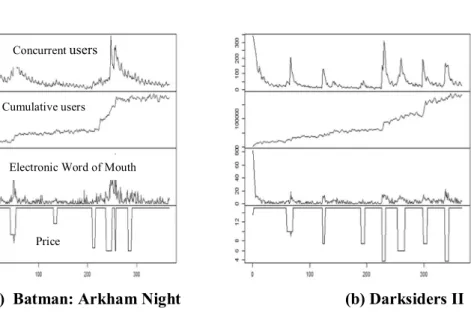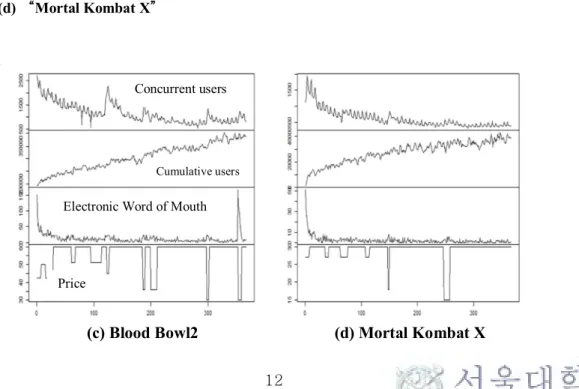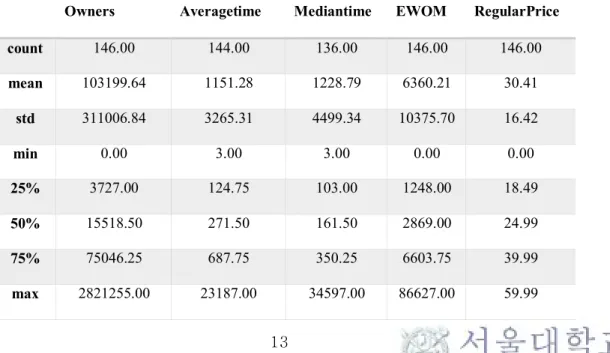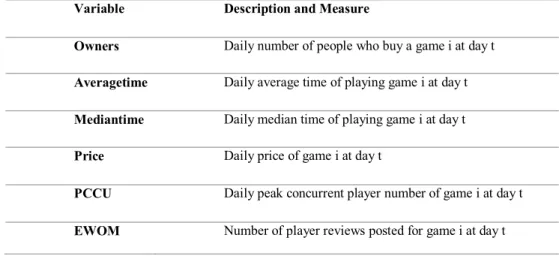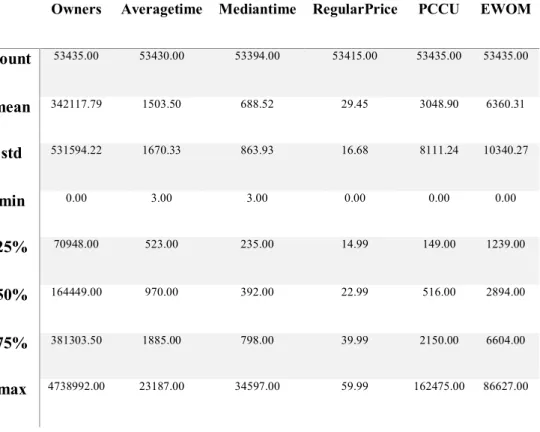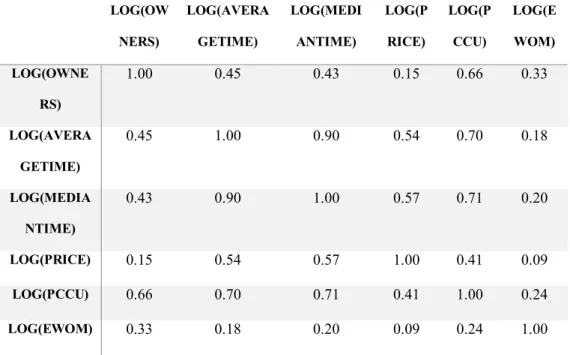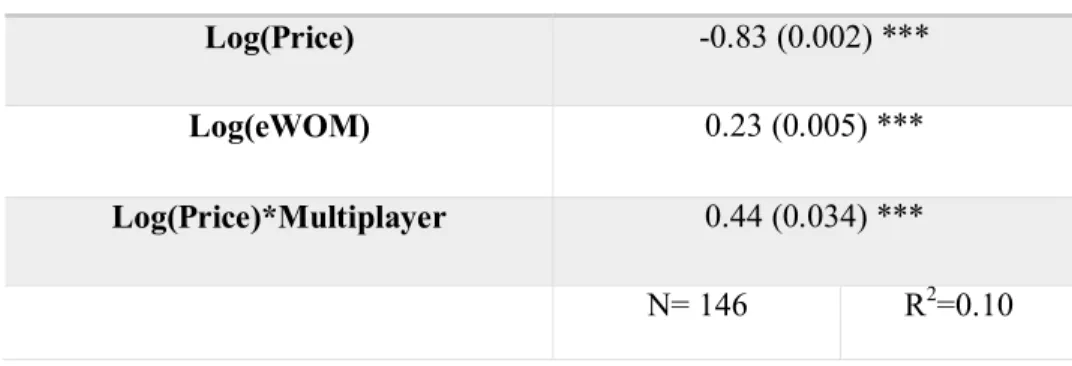저작자표시-비영리-변경금지 2.0 대한민국 이용자는 아래의 조건을 따르는 경우에 한하여 자유롭게
l 이 저작물을 복제, 배포, 전송, 전시, 공연 및 방송할 수 있습니다. 다음과 같은 조건을 따라야 합니다:
l 귀하는, 이 저작물의 재이용이나 배포의 경우, 이 저작물에 적용된 이용허락조건 을 명확하게 나타내어야 합니다.
l 저작권자로부터 별도의 허가를 받으면 이러한 조건들은 적용되지 않습니다.
저작권법에 따른 이용자의 권리는 위의 내용에 의하여 영향을 받지 않습니다. 이것은 이용허락규약(Legal Code)을 이해하기 쉽게 요약한 것입니다.
Disclaimer
저작자표시. 귀하는 원저작자를 표시하여야 합니다.
비영리. 귀하는 이 저작물을 영리 목적으로 이용할 수 없습니다.
변경금지. 귀하는 이 저작물을 개작, 변형 또는 가공할 수 없습니다.
경영학 석사 학위논문
Justification Effect of Social Capital:
An Empirical Analysis of the Game Industry
사회자본의 정당화 효과:
게임 산업의 실증적 분석
2018년 7월
서울대학교 대학원
경영학과 경영학 전공
최한울
Justification Effect of Social Capital:
An Empirical Analysis of the Game Industry
지도 교수 김병도
이 논문을 석사 학위논문으로 제출함
2018년 7월
서울대학교 대학원
경영학과 경영학 전공
최한울
최한울의 경영학 석사 학위논문을 인준함
2018년 7월
위 원 장 이유재 (인)
부위원장 김상훈 (인)
위 원 김병도 (인)
Abstract
Consumers generally feel guilt when they are purchasing products. Previous studies argue that consumers feel less guilty and justify their consumption more easily when they are purchasing utilitarian products, but hedonic consumption cannot be easily justified. In this study, I argue that there are different types of hedonic products and some of those can be more easily justified than others. I define that there are two types of hedonic products: socializing hedonic product and non-socializing hedonic product. Socializing hedonic product is a hedonic product which improves one’s social capital such as a soccer ball, while non- socializing product is a hedonic product which is not related to social capital such as a music album. A person who has higher social capital can gain three main benefits: information, power, and solidarity. Since socializing hedonic products are promoting social capital, a person who purchase a socializing hedonic product generally expect to have those benefits. Although most of hedonic consumptions bring a sense of guilty feeling, socializing hedonic consumption does not cause guilt much because the benefits of social capital justify the consumption.
In this study, I examine the hypothesis that consumption of a product which promotes social capital is more easily justified than consumption of a product which is not related to social capital. To support my hypothesis, I use the data from PC game platform Steam. There are two kinds of games in Steam: multiplayer game and single-player game. Multiplayer game(MPG) is regarded as a socializing hedonic product and single-player game (SPG) as a non-socializing hedonic product. From the analysis, price promotion and price reduction have a stronger positive effect on the sales and popularity of SPG than those of MPG. The result of this study supports that firms should focus on other than price promotion while they are selling socializing hedonic products.
Keywords: justification effect, social capital, game industry, guilt, price promotion, hedonic consumption
Student Number:2013-20543
Table of Contents
Chapter 1. Introduction ... 1
Chapter 2. Literature Review... 2
2.1. Guilt and Hedonic Consumption………...2
2.2. Justification effects………3
2.3. Social Capital……….5
Chapter 3. Hypotheses ... 9
Chapter 4. Research Methodology... 11
4.1. Description of the data and measures………..11
4.2. Empirical Model Specification………14
Chapter 5. Results ... 17
Chapter 6. Conclusions ... 19
References ... 21
Abstract in Korean... 23
Tables
Table 1. Summary statistics of the game sample... 13
Tabel 2. Key variables, descriptions, and measures... 14
Tabel 3. Summary statistics of the daily data... 15
Tabel 4. Correlation matrix of key daily variables ... 16
Tabel 5. PCCU Fixed effects model estimation results... 18
Tabel 6. Owner Fixed effects model estimation results ... 19
Figures
Figure 1. Dynamics of concurrent player number, cumulative owners (sales), review volume (eWOM), and price change of single-player games... 12Figure 2.Dynamics of concurrent player number, cumulative owners (sales), review volume (eWOM), and price change of Multiplayer games………...12
1. Introduction
Imagine that a person purchases a soccer ball. This person might play with the soccer ball by himself, but mostly he will play soccer with his friends or family members using this soccer ball. On the other hand, the same person buys a music album of Frank Ocean from iTunes. He will listen to this music album by himself mostly. Both the soccer ball and the music album are regarded as hedonic products.
However, they are not a same type of hedonic products. Soccer ball is a product that people use together, while a music album is mostly used by a buyer only. In this study, I define two types of hedonic products: socializing products and non- socializing products. I also argue that consumer will behave differently when they buy a socializing product and a non-socializing product.
Previous research has shown that people can easily justify their utilitarian consumption while it is more difficult for them to justify their spending on hedonic goods and services because hedonic consumption causes a sense of guilt (Prelec &
Loewenstein, 1998). To reduce a sense of guilty and justify their consumption, people perform altruistic behaviors, expend efforts, and finding deals such as price promotion (Khan and Dhar 2006, Khan and Dhar 2010, Kivetz and Simonson 2002, Kivetz and Zheng 2006, Lee-Wingate and Corfrman 2010).
This study examines the hypothesis that hedonic consumption can create a less feeling of guilty when a hedonic product promotes social capital. People try to gain social capital because it gives a person to have some benefits such as information, power, and solidarity (citation). These benefits make people to have less feeling of guilty when they are buying a socializing product. Since hedonic products with social capital decrease the feeling of guilty of hedonic consumption,
people can justify their consumption and hence they do not need to perform additional behavior such as finding deals to reduce a sense of guilt more. People become less price sensitive when they do not feel guilty much about their consumption.
To prove the hypothesis, this study uses computer game sales data with price changes. I divide computer games to two groups: single-player games (SPGs) and multiple-player games (MPGs). While SPGs do not contains a feature of communication and socialization with other players, MPGs have a feature that users can communicate and socialize inside of the games. A pilot data analysis using the fixed effects model shows that both SPGs and MPGs are price sensitive since they are hedonic consumption; however, MPGs are significantly less price sensitive than SPGs.
2. Backgrounds
In this chapter, I state that how previous studies explain the main concepts of my study. Guilt and hedonic consumption, justification effect, and social capital are explained. Moreover, I describe what have not been covered previously from past studies.
2.1 Guilt and Hedonic Consumption
Both hedonic and utilitarian products offer benefits to the consumer, the former primarily in the form of experiential enjoyment and the latter in practical functionality. Hedonic purchases are typically motivated by the desire for fun and sensual pleasure and often involve products that are frivolous or luxurious. In contrast, utilitarian purchases are typically motivated by basic needs and often
involve practical or necessary products. Although hedonic goods are more attracting and tempting than utilitarian goods, it is often harder to justify hedonic consumption (Okada, 2005).
Because of this difference, there is a sense of guilt associated with hedonic consumption (Kivets and Simonson 2002). It is more difficult to justify spending on hedonic goods and easier to justify spending on utilitarian goods (Prelec and Loewenstein 1998). Spending money on hedonic productsoften creates intra- personal conflict between the desire for indulgence and the need for prudence, because spending money on indulgences depletes one's monetary resources that are essential for the basic needs of one's life (Kivetz 2005). In contrast, spending money on utilitarian products or services has a natural justification: one simply cannot do without such items.
When the sense of guilt is mitigated, hedonic consumption increases. Guilt might make hedonic consumption more difficult to justify and a sense of guilt may arise in anticipation or make an unjustifiable choice. Okada (2005) states that guilty and justification are interrelated concepts rather than competing theories.
People are motivated to consume hedonic goods but will be less likely to do so when the situation makes it difficult for them to justify it. To reduce a sense of guilt of hedonic consumption, consumers do some works and firms try to use some strategies.
2.2 Justification Effects
Previous research indicates three ways consumers mitigate guilt associated with hedonic purchases: (1) perform altruistic behaviors (Khan and Dhar 2006; Lee-
Wingate and Corfman 2010), (2) expend effort (Kivetz and Simonson 2002;
Kivetz and Zheng 2006), and (3) find deals (Khan and Dhar 2010; Zheng and Kivetz 2009). Performing altruistic behaviors can offset the guilt associated with self-centric consumption and serve as justification for hedonic purchases. Khan and Dhar (2006) found that people who imagined engaging in an altruistic behavior prior to choosing between a necessity and a luxury were more likely to select the more luxurious option because they felt morally licensed to do so. In addition, Lee-Wingate and Corfman (2010) found that people can reduce the guilt evoked by consuming self-indulgent items by engaging in a kind behavior toward someone else.
Another way that consumers can reduce guilt and justify hedonic consumption is through the expenditure of effort. People who have performed a difficult task may feel they have earned the right to engage in hedonic consumption as a reward for their hard work. Kivetz and Zheng (2006) found that higher effort and positive feedback increased preference for vice to virtue rewards because people felt entitled to them. Kivetz and Simonson (2002) investigated when consumers choose luxury over necessity rewards with frequency programs. They found that consumers were more likely to choose luxury over necessity rewards when the frequency program had high program requirements, presumably because higher efforts reduced the guilt that is associated with hedonic consumption.
Third, finding deals is an effective way to reduce guilt and increase hedonic consumption. Consumers may justify purchasing a desirable but unnecessary
product by reasoning that they did not pay full price. In support of this, Zheng and Kivetz (2009) showed that sales promotions enhance the purchase likelihood of hedonic products but have little impact on utilitarian ones. Using cross- category bundles containing both hedonic and utilitarian products, Khan and Dhar (2010) showed that a bundle discount increased purchase likelihood if the discount appeared to represent savings on the hedonic product but not on the utilitarian product.
Finally, consumers try to investigate the attributes of hedonic products so that they can justify their consumption is much more valuable. John Peloza (2013) found that a consumer who buys a pro-social hedonic product can easily justify his or her consumption because the product has altruistic value and he believes that the consumption will lead to a better society. In the next section, I will describe one attribute, which can make consumers feel less guilty about their hedonic consumption: a socializing attribute
2.3 Social Capital
Many researches from sociology, politics, and business have defined the term of
"social capital", and a number of these definitions can be grouped by two. First group shows that social capital is a resource which focal actors can achieve through tying to other actors. The other group focuses on more collective benefits.
Baker (1990) defines that social capital is a resource that actors derive from specific social structures and use to their own interests. Bourdieu (1985) defines that social capital is made from social connections and it can be convertible to economic capital and institutionalized in the form of a title of nobility. Burt (2000)
defines that social capital makes people to have opportunities to use their financial and human capital from their social contacts. Portes (1998) defines that social capital gives actors benefits from membership of social networks or other social structures. These definitions mostly agree that social capital give benefits to individuals and the benefits are quite practical and direct
On the other hand, Fukuyama (1997) states that social capital is the existence of a certain set of informal values or norms shared among members of a group that permit cooperation among them. Putnam states that social capital has features of social organization such as networks, norms and social trust that facilitates coordination and cooperation for mutual benefit. These benefits are mostly for collective groups and not much for individuals. This study is going to focus more on the first type of definitions and argue that social capital give benefits to individuals.
Social capital can be also divided by two groups. Putnam (2000) distinguished social capital between bridging and bonding social capital. Bridging social capital is closely linked to what network researchers refer to as
“weak
ties”, which considers loose connections between individuals who may provide useful information or new perspective for one another but typically not emotional support (Granovertter, 1983). By contrast, bonding social capital is closely linked to strong ties; it considers bonds that are observed between individuals in tightly- knit and emotionally close relationships, such as those felt among family and close friends.People try to gain social capital because social capital directly or indirectly gives some benefits.
First benefit is information. Coleman (1988) states that an individual with higher social capital can get more information about job opportunities form his ties when he is trying to find a job. Burt (2000) argue that social capital gives access, timing, and referral benefits through information.
Second type of benefit is power. Coleman (1988) argues that social capital makes an individual become a more powerful and influential person. People with higher social capital are generally in touched with many various types of people and it makes them to become have power. Burt (2000) supports that a person who has higher social capital usually become a leader of a group.
Finally, social capital gives solidarity to an individual. When people become a member of one group, he can easily get more sensitive and richer information because he has solidarity and has strong ties with other members. Even weak ties make people to have benefits of solidarity. Many scholars state that weak ties can give more gains than no ties.
In business field, social capital is an important concept. Firms or organizations with high social capital usually perform with better performance than those with low social capital. Therefore, firms try to make strong social ties in the organizations. In marketing, most studies of social capital are related with word of mouth (WOM). Libai (2010)argue that consumers who are willing to get information from WOM generally use their social capital to have better quality information. Hung and Li (2007) states that an electronic community with higher social capital tends to have more credible electronic word of mouth. Chu and Choi (2011) argue that American consumers tend to have more bridging social capital and less bonding social capital than Chinese consumers and hence, Chinese consumers can get better information from eWOM of online communities.
Putnam (2000) distinguished social capital between bridging and bonding social capital. Bridging social capital is closely linked to what network researchers refer to as
“weak ties”, which considers loose connections between individuals who
may provide useful information or new perspective for one another but typically not emotional support (Granovertter, 1983). By contrast, bonding social capital is closely linked to strong ties; it considers bonds that are observed between individuals in tightly-knit and emotionally close relationships, such as those felt among family and close friends.Previous marketing social capital studies argue that consumers with higher social capital and those with lower social capital behave differently.
Moreover, retail stores with higher social capital perform better than those with lower social capital. For example, Merlo et al (2006) state that structural, relational, and cognitive dimensions of social capital in retail stores help to make better customer service orientation. As a result, the retail stores become more creative.
Chu and Choi (2011) argue that Chinese consumers in the electronic community generally have higher bonding social capital than American consumers do and therefore, Chinese consumers tend to trust eWOM more in the community they belong than American consumers.
In this study, I do not regard social capital as a consumer characteristic nor a store characteristic and rather, I argue that social capital is one of product attribute.
More specifically, there are products that enhance social capital and I am going to call those products that have a socializing attribute. In the following section, I am going to argue how a socializing attribute influences to consumers.
3. Hypotheses
People may purchase products to gain social capital or they do not expect any social capital from their consumption. Some people might buy hedonic products to enjoy them with their closely linked people. For example, a woman buys four airplane tickets for traveling Paris with her new friends and she probably expect that she will get more emotionally closer to those friends. Also, a teen boy buys a soccer ball to play soccer with his new classmates. By playing soccer, he would be closer to his classmates. These examples show that people can promote bonding social capital through the hedonic consumption.
On the other hand, people may purchase products to find new relationships. For example, a traveler reserves a guest house rather than a hotel even though a hotel protects his privacy because one of his goal from the travel is find new friends, and a guest house is a proper place to make new friends.
Moreover, a man buys a new online PC game to have fun with other players that he has never met before. From the new online game, he expects that he will make some new online friends. These examples show that people can gain bridging social capital from the hedonic consumption.
Obviously, there are hedonic products that are not related with social capital. A girl buys macarons because she wants to eat them by herself. Also, a man purchases some songs from the iTunes to listen them when he goes to work.
Those consumptions are not related to other people, they are only enjoyable to consumers. In this study, I separate hedonic consumption to three groups: bonding social capital consumption, bridging social capital consumption, and non-social capital consumption.
Both bonding and bridging social capital consumptions have somewhat long-term hedonic value than non-social capital consumption has, since social capital makes hedonic products more continuously enjoyable. For example, a traveler who stayed in a hotel by himself might enjoy his journey but his enjoyable and fun experience during the travel do not last long. On the other hand, another traveler who stayed in a guest house might enjoy his journey, although he was not very comfortable sleeping there, and his enjoyable experience would last long since he met some new people in a guest house and became friends. Therefore, hedonic consumption with social capital gives less a feeling of guilty than hedonic consumption without social capital because social capital can last long like a utilitarian attribute. As a result, hedonic consumption with social capital are more justifiable than hedonic consumption without social capital.
H1: Price promotions will have a stronger positive effect on the purchase likelihood of non-social hedonic products than social hedonic products
Kivetz and Zheng (2017) shows that price promotions have a stronger positive effect on the purchase likelihood of hedonic products than utilitarian products. Since people perceive social hedonic products are more practical than non-social hedonic products, social hedonic products are less price sensitive than non-social hedonic products.
H2: Price promotions will have a stronger positive effect on the purchase likelihood of bonding - social hedonic products than bridging - social hedonic products.
4. Research Methodology
4.1 Description of the data and measures
The sample for this study was collected from the online game platform called Steam. Steam is a digital distribution multiplayer and communications platform developed by Valve Corporation. It distributes single-player games and online games, both from small independent developers to larger software houses. The platform was created in 2002, and since then there are more than 40 million registered users now (Becker, Chernihov, & Zilberman, 2012). From the platform, I initially collected general information such as genre, game category, and developer and publisher names of 175 games which were released in 2015 and 2016 from the official website by crawling method. Next, I collected dynamic data of these games such as daily price, daily concurrent player number, and estimated daily sales from the website
“Steamspy.com”
Steamspy.com provides a sales tracking service for online and single-player video games served by Steam.Although the Steamspy.com sales data are collected by a sampling approach using approximately 100,000 to 150,000 user accounts per day, they are known to be highly accurate within a 0.33% error margin (Gilbert, 2016).
Out of 175 games, we excluded 24 games because they are free to play or game prices are less than five dollars. Here I try to show how largely price promotion influence on sales of single-player games and multiple-players games.
Free to play and too cheap priced games are not relevant. Eventually, there were 146 games left; 85 games were categorized as multi-player games (MPGs), and rest 61 games (SPGs) were not. I constructed a panel data set of 146 games for one year (366days). Table 1 presents the summary statistics for our game sample.
Figure 1.Dynamics of concurrent player number, cumulative owners (sales), review volume (eWOM), and price change of single-player games (a) “Batman: Arkham Knight”and (b) “Darksiders II”
Figure 2.Dynamics of concurrent player number, cumulative owners (sales), review volume (eWOM), and price change of Multiplayer games (c) “Blood Bowl 2” and (d)“Mortal Kombat X”
(a) Batman: Arkham Night (b) Darksiders II
(c) Blood Bowl2 (d) Mortal Kombat X
Concurrent users
Cumulative users Electronic Word of Mouth
Price
Concurrent users
Cumulative users
Electronic Word of Mouth
Price
Table2 provides the description and measurement of the key variables used in the empirical analysis. Tables 3 and 4 show the summary statistics and correlation matrix for the 6 one-year daily data sample we use for the empirical estimation. We observed that, for most games, the number of concurrent users soars in the first few weeks after the release and drops significantly afterward. Such pattern is very similar to the owners change.
For illustration, Figure1 and Figure 2 show how the concurrent users, owner number change, review volume, and price change over time on a daily basis.
Figure 1 a and b demonstrate single-player games and Figure 2 c and d demonstrate multiplayer games. Figure 1 graphs display remarkably similar patterns on the day- today basis, even for temporal increases and drops. Moreover, when there is a price promotion (usually two to four days), the players number increases sharply, but the increasing amount is diminishing over time. From these graphs, the popularity of games and the sales of games are highly related with the price promotion.
Table1. Summary statistics of the game sample
Owners Averagetime Mediantime EWOM RegularPrice
count 146.00 144.00 136.00 146.00 146.00
mean 103199.64 1151.28 1228.79 6360.21 30.41
std 311006.84 3265.31 4499.34 10375.70 16.42
min 0.00 3.00 3.00 0.00 0.00
25% 3727.00 124.75 103.00 1248.00 18.49
50% 15518.50 271.50 161.50 2869.00 24.99
75% 75046.25 687.75 350.25 6603.75 39.99
max 2821255.00 23187.00 34597.00 86627.00 59.99
Table 2. Key variables, descriptions, and measures
4.2 Empirical Model Specification
This study tries to figure out that price promotion gives more positive effect on the purchase likelihood of non-social hedonic products than social hedonic products. In the data, I determine that Multiplayer Games (MPGs) are social hedonic products and Single-player Games (SPGs) are non-social hedonic products. Hau and Kim (2011) argue that online game players motivate to play online game because they are expecting to gain some social capital by playing the game. First, I am interested in the price promotion effect on the popularity. To measure the popularity, I use Peak concurrent player number (PCCU). PCCU refers to the total number of people playing the game within a predefined period. Also, I am interested in the price promotion effect on the sales and I use daily owner increasing number (Owner) as daily sales. Both PCCU and Owner are dependent variable for each equation. Then price and price and Multiplayer dummy variable interaction are used for the main independent variables. In addition, following extant research, I
Variable Description and Measure
Owners Daily number of people who buy a game i at day t Averagetime Daily average time of playing game i at day t Mediantime Daily median time of playing game i at day t Price Daily price of game i at day t
PCCU Daily peak concurrent player number of game i at day t EWOM Number of player reviews posted for game i at day t
use a log-linear formulation in the model. The log-linear formulation is consistent with theoretical models of a multistage consumer decision-making process, where sales of a game can be viewed as a series of conditional probabilities applied to the consume base. A log transformation converts the relationship into a linear form for empirical estimation. Moreover, log transformation smoothes the distribution of variables in the linear regression, and the estimated coefficients of the log-linear form directly reflect the elasticity of independent and dependent variables.
Table 3. Summary statistics of the daily data
Owners Averagetime Mediantime RegularPrice PCCU EWOM
count 53435.00 53430.00 53394.00 53415.00 53435.00 53435.00
mean 342117.79 1503.50 688.52 29.45 3048.90 6360.31
std 531594.22 1670.33 863.93 16.68 8111.24 10340.27
min 0.00 3.00 3.00 0.00 0.00 0.00
25% 70948.00 523.00 235.00 14.99 149.00 1239.00
50% 164449.00 970.00 392.00 22.99 516.00 2894.00
75% 381303.50 1885.00 798.00 39.99 2150.00 6604.00
max 4738992.00 23187.00 34597.00 59.99 162475.00 86627.00
To control for any game idiosyncratic factors that could influence sales and PCCU, such as budget, marketing, and others, I include fixed effects in the model by adding movie-specific dummy variables. Fixed effects capture any non-
time varying factors, including intrinsic game characteristics, critic reviews, and other exogenous determinants. In addition fixed effects estimation also allows the error term to be arbitrarily correlated with other explanatory variables, thus making the estimation results more robust.
Table 4. Correlation matrix of key daily variables
LOG(OW NERS)
LOG(AVERA GETIME)
LOG(MEDI ANTIME)
LOG(P RICE)
LOG(P CCU)
LOG(E WOM) LOG(OWNE
RS)
1.00 0.45 0.43 0.15 0.66 0.33
LOG(AVERA GETIME)
0.45 1.00 0.90 0.54 0.70 0.18
LOG(MEDIA NTIME)
0.43 0.90 1.00 0.57 0.71 0.20
LOG(PRICE) 0.15 0.54 0.57 1.00 0.41 0.09
LOG(PCCU) 0.66 0.70 0.71 0.41 1.00 0.24
LOG(EWOM) 0.33 0.18 0.20 0.09 0.24 1.00
PCCU equation log(PCCU)it
= β1i+ β2ilog(Priceit) + β3ilog(eWOMit) + β4i
log( Priceit)*Multiplayeri+ eit (1)
In the first equation, I define the concurrent player number of a game i at time t as
PCCUi,t and use key variables that influence on concurrent player number are
Priceit and eWOMitand Priceit and Multiplayeri interaction. In this equation, I used
PCCU as a dependent variable to find out how differently price promotion influences on social hedonic products and non-social hedonic products.
Sales equation log(Sales)it
= β1i+ β2ilog(Priceit) + β3ilog(eWOMit) + β5ilog(Priceit)*Multiplayeri
+ eit (2)
In the second equation, I define the sales of a game i at time t as salesi,t and use key variables same as the first equation. There is one more key independent variable concurrent player number which is also a dependent variable of the first equation because I try to find out how the price change influence only on the new users.
There is a possibility that old-users are influenced by the price change since price change makes a game more popular and attract many new users. One of the most fun values of online game came from a large pool of users, since the price promotion makes a pool of the game larger, the old-user might come back to play the game again.
5. Results
The fixed effects regression procedure was used in this study. First, PCCU equation shows that the popularity of a game is highly related with the price promotion. When there is a price promotion PCCU increase, since the price coefficient is -0.76. It shows that when the game i price decreases (price promotion occurs or price reduction occurs), more players play game i. This result may shows
that price promotion attracts new players and gather old players. Also, the eWOM coefficient is 0.48 and it shows the eWOM and PCCU are significantly related.
Since many previous eWOM studies often show that eWOM and popularity relationship, this study will not focus on this result. The main variable which is the interaction term between price and Multiplayer dummy variable has the coefficient of 0.74, corresponding to a t-statistics of 29.98 (p<0.01). It shows that price promotion effect on the popularity is significantly stronger to SPGs than MPGs.
These results show that social products are less price sensitive than non-social products, and supports the H2.
Table 5. PCCU Fixed effects model estimation results
Variable Coefficient (Std. Err.)
Log(Price) -0.77 (0.014) ***
Log(eWOM) 0.47 (0.004) ***
Log(Price)*Multiplayer 0.74 (0.02) ***
N= 146 R2=0.40
The sales equation was also shows very similar results to the PCCU equation. Obviously, sales and price relationship are significantly strong. On the other hand, compare to PCCU, the effect of eWOM is not that powerful to the sales of products. Finally, the interaction term between price and multiplayer dummy variable was also highly significant and this result shows that price promotion effect on sales are more powerful to SPGs than MGs. These results also support the hypothesis that price promotion effect is less effective to social hedonic products.
Table 6. Owner Fixed effects model estimation results
Variable Coefficient (Std. Err.)
Log(Price) -0.83 (0.002) ***
Log(eWOM) 0.23 (0.005) ***
Log(Price)*Multiplayer 0.44 (0.034) ***
N= 146 R2=0.10
6. Conclusions
The objective of this study is to figure out the impact of an attribute which improves social capital. My results yield that consumption of hedonic products which promote social capital is easily justified because it causes less guilt than that of hedonic products which are not related to social capital. Since socializing hedonic consumptions are easily justified, I hypothesize that hedonic products which promote social capital are less price sensitive than hedonic products which are not related to social capital.
I developed fixed effect model to find out the relationship between a price promotion effect and a socializing attribute. My model shows that price promotion has a stronger effect on hedonic products which have a socializing attribute than hedonic products which are not related to a socializing attribute.
My results suggest that firms which are selling socializing hedonic products should more focus on other types of promotion than price promotion because those products are not price sensitive.
There are certain limitations on this study. First, this study does not contain consumer data. Consumers who buy multiplayer games and those who
buy single-player games might have different characteristics. Second, price promotions are varied among games from the steam data. Some of games conduct price promotion more than ten times during a year after they first released while other games conduct less than five times.
References
Alba, J., & Williams, E. (2013). Pleasure Principles: A Review of Research on Hedonic Consumption. Journal of Consumer Psychology, 23(1), 2-18.
Baker, W. E. (1990). Market Networks and Corporate Behavior. American Journal of Sociology, 96(3), 589-625.
Becker, R., Chernihov, Y., & Zilberman, N. (2012). An analysis of the Steam community network evolution. 2012 IEEE 27th Convention of Electrical and Electronics Engineers in Israel, 1-5.
Bourdieu, P. (1985). The social space and the genesis of groups. Social Science Information , 24(2) 195-220.
Burt, R. R. (2000). The Network Structure Of Social Capital. Research in Organizational Behavior, 22 345-423.
Chu, S. C. (2011). Electronic word-of-mouth in social networking sites: A cross- cultural study of the United States and China. Journal of Global Marketing, 24(3), 263-281.
Coleman, J. S. (1998). Social Capital in the Creation of Human Capital. American Journal of Sociology, 94, 95-S120.
Fukuyama, F. (1997). Social capital and the modern capitalist economy: Creating a high trust workplace. Stern Business Magazin, 4(1), 1-16.
Gilbert, D. (2016, May 26). Let's Talk Steam Spy. Retrieved from Wadjeteyegames.: http://www.wadjeteyegames.com/2015/04/
Granovetter, M. (1993). The Nature of Economic. Explorations in economic sociology.
Holbrook, M. (2006). Consumption experience, customer value, and subjective personal introspection: An illustrative photographic essay. Journal of Business Research, 59(6), 714-725.
Hung, K. H. (2007). The influence of eWOM on virtual consumer communities:
Social capital, consumer learning, and behavioral outcomes. Journal of advertising research, 47(4), 485-495.
John Peloza, K. W. (2013). Good and Guilt-Free: The Role of Self-Accountability in Influencing Preferences for Products with Ethical Attributes. Journal of Marketing, 77:1, 104-119 .
Khan, U., & Dhar, R. (2006). Licensing effect in consumer choice. Journal of Makreting Research, 43(2), 259-266.
Khan, U., & Dhar, R. (2010). Price framing effects on purchase of hedonic and utilitarian bundles. Journal of Marketing Research, 47(6), 1090-1999.
Kivetz, R., & Simonson, I. (2002). Earning the right to indulge: effort as as determinant of customer preferences toward frequency program rewards.
Jounrla of Makreting Research, 39(2), 155-170.
Kivetz, R., & Zheng, Y. (2006). Determinants of justification and self-control.
Journal of Experimental Psychology: General, 135(4), 155-170.
Lee-Wingate, J., & Corfrman, K. (2010). A little something for me and maybe you, too: promotions that relieve guilt. Marketing Letters, 21(4), 385-395.
Libai, B. B. (2010). Customer-to-customer interactions: broadening the scope of word of mouth research. . Journal of service research, 13(3), 267-282.
Merlo, O. B. (2006). Social capital, customer service orientation and creativity in retail stores. Journal of Business Research, 59(12), 1214-1221.
Okada, E. (2005). Justification Effects on Consumer Choice of Hedonic and Utilitarian Goods. Journal of Maketing Research, 42(1), 43-53.
Portes, A. (1998). Social Capital: Its Origins and Applications in Modern Sociology. Annual Review of Sociology, 24 1-24.
Prelec, D., & Loewenstein, G. (1998). The Red and the black: Mental Accounting of Savings and Debt. Marketing Science, 17(1), 4-28.
Putnam, R. D. (2000). Bowling alone: America’s declining social capital. In Culture and politics.New York: Palgrave Macmillan.
Ryan, R., & Deci, E. (2000). Self-Determination Theory and the Facilitation of Intrinsic Motivation, Social Development, and Well-Being. American Psychology, 55(1), 68-78.
Zheng, Y., & Kivetz, R. (2009). The differential promotion effectiveness on hedonic versus utilitarian products. Advances in Consumer Research, 26, 565.
국 문 초 록
사회자본의 정당화 효과:
게임 산업의 실증적 분석
최한울 경영학과 경영학 전공 서울대학교
소비자들은 일반적으로 소비 활동을 할 때 죄책감을 느낀다. 선행연구들은 소비자들이 쾌락재를 구매할 때 실용실용 구매할 때 보다 더 죄책감을 많이 느낀다고 보고 있다. 본 연구에서 쾌락재를 사회적자본을 증진시키는 쾌락재와 사회적 자본과 관련이 없는 쾌락 재로 나누었다. 전자의 경우는 축구공처럼 소비자가 다른 사람들과 함께 즐길 수 있는 사회적 쾌락재로 정의하고 후자의 경우에는 음악 앨범처럼 혼자 즐길 수 있는 사회적 관련이 없는 쾌락재로 정의한다. 소비자들이 사회적 쾌락재를 구매하고자 하였을 때 사 회적자본의 이익을 얻을 수 있다는 것을 쉽게 인식을 할 수 있기에 사회적 자본의 혜택 (정보의 습득, 기회, 결속력)에 의해 소비의 죄책감을 덜 느끼고 이로 인하여 소비가 좀 더 쉽게 정당화될 수 있다. 그리하여 사회적 쾌락재의 경우 사회적 관련이 적은 쾌락재 보다 가격에 덜 민감하다는 가설을 세운다.
이 가설을 증명하기 위해 국제적 게임 플랫폼인 스팀의 데이터를 사용하여 분 석을 하였다. 스팀은 다른 게임 사용자와 같이 즐길 수 있는 멀티플레이어 게임과 혼자 서만 즐길 수 있는 싱글플레이어 게임이 존재하는데, 본 연구에서는 멀티플레이어 게임 을 앞서 언급한 사회적 쾌락재로, 싱글플레이어 게임을 사회적 관련이 적은 쾌락재로 취 급한다. 이 데이터를 고정효과(fixed effects) 모델을 사용하여 분석한 결과 멀티플레이 어 게임이 싱글플레이어 게임보다 가격에 덜 민감하다는 것을 볼 수 있다. 분석결과는 즉, 사회적 쾌락재는 다른 쾌락재에 비하여 가격 프로모션에 영향을 덜 받는다는 주장을
뒷받침한다. 이를 통해 사회적 쾌락재를 판매하고 있는 회사들은 제품의 판매량을 늘리 고자 할 때 가격 프로모션보다는 다른 프로모션 방법을 사용이 효과적이라고 제시한다.
